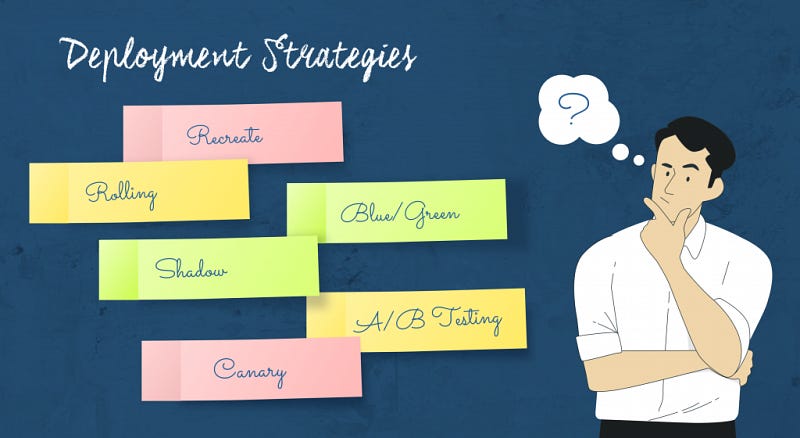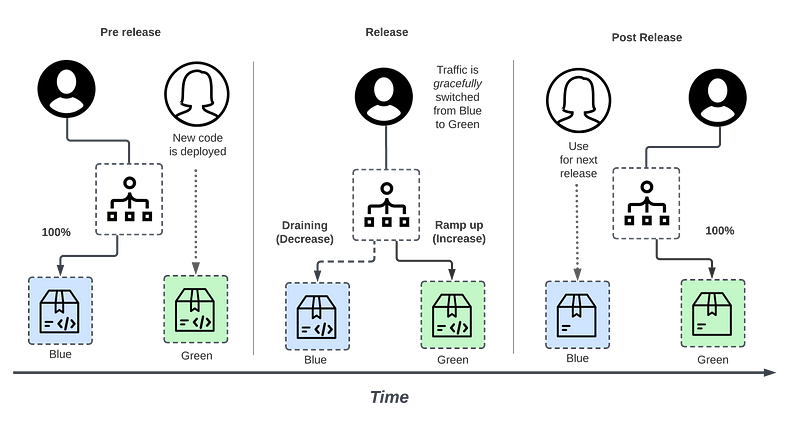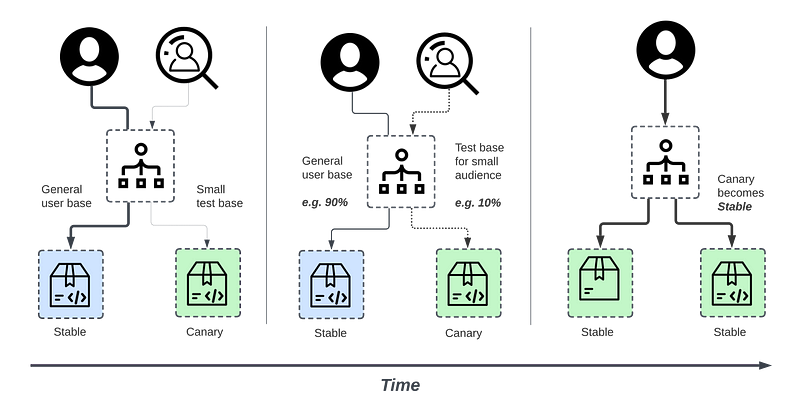Exploring the Top 3 Strategies with Real-World Examples.
 Gurpreet Singh
Gurpreet SinghTable of contents

source : https://blog.qburst.com/
In the dynamic world of software development, deployment is not just the final step but a vital phase that determines a product’s success in the market. The choice of deployment strategy can significantly affect the availability, stability, and reception of new features. This guide offers a deep dive into three pivotal deployment strategies: Blue-Green, Canary, and Rolling Deployments. Each of these approaches plays a critical role in modern continuous delivery and integration practices, ensuring a seamless transition from development to user adoption.
By examining the operational frameworks and real-world examples from industry leaders, we provide insight into how these strategies are applied in various scenarios to maximize efficiency and minimize risk. Whether it’s the robust safety net of Blue-Green Deployment, the measured user engagement of Canary Deployment, or the systematic update process of Rolling Deployment, the knowledge of these strategies is crucial. They allow for flexibility and resilience in a tech environment that demands both rapid innovation and unfaltering reliability. With this guide, you’ll gain the understanding needed to select and implement the most appropriate deployment approach for your software’s unique needs.
Blue-Green Deployment

source : https://www.cncf.io/
What is Blue-Green Deployment?
The Blue-Green Deployment strategy is akin to having two identical production environments that are as close to identical as possible. One, the Blue environment, hosts the current application version, while the Green is poised to roll out the next release. At any given time, only one environment is live, serving all production traffic.
Benefits and Scenarios for Use
The strength of Blue-Green Deployment lies in its simplicity and immediacy. When it’s time to deploy, traffic is switched from the Blue to the Green environment, making the new version active. If issues arise, a rollback is just a switch away, back to the Blue environment. This method shines in high-availability applications where downtime equates to lost revenue and diminished user experience. It’s perfect for scheduled updates and feature rollouts that can be planned and executed with precision.
Potential Drawbacks
Despite its advantages, Blue-Green Deployment isn’t without its challenges. It requires double the environment infrastructure, leading to increased costs. Moreover, database schema changes must be backward-compatible to ensure seamless rollbacks, adding complexity to database management.
Real-World Example: eCommerce Platform Deployment
Consider a global eCommerce platform, like Amazon, during Black Friday sales. For them, downtime is not an option. By employing Blue-Green Deployment, they can deploy a new version of their platform to the Green environment while the Blue one is still operational. Once the new version is fully tested and deemed stable, the traffic is directed to the Green environment. If an unexpected issue arises, they can swiftly revert to the Blue environment. This strategy ensures that millions of users continue to have a seamless shopping experience, even during the busiest of times, and any new features or updates are deployed with minimal risk to the user experience and the company’s operations.
Canary Deployment

source : https://www.cncf.io/
Understanding Canary Deployment
Named after the age-old practice of using canaries in coal mines as early warning signs, Canary Deployment serves a similar purpose in the digital realm. This strategy involves releasing a new feature or service incrementally to a small, controlled group of users before a full rollout. The idea is to test the waters with real users on production servers to detect any potential issues before they affect the entire user base.
Advantages and Considerations
Canary Deployment is highly effective for risk mitigation. By closely monitoring the performance and collecting user feedback, developers can make adjustments in real-time. This gradual rollout process allows for the identification and resolution of any unforeseen bugs or performance issues with minimal impact.
The strategy is also particularly valuable when deploying to diverse user bases or when introducing significant changes where user feedback is critical to the deployment’s success. However, it does require a robust monitoring infrastructure to measure the impact effectively, and it may not be suitable for all types of applications, particularly those with a small user base where a ‘canary’ segment might not be statistically significant.
Real-World Example: Social Media Feature Rollout
Twitter, for instance, often utilizes Canary Deployments when introducing new features. When they first released the “Fleets” feature, akin to stories on other social platforms, they did so for a subset of users from various regions. This allowed Twitter to gather data on the feature’s usage and performance, monitor for bugs, and assess user reception. Based on this feedback, they made adjustments before deciding on a wider release. Such a cautious approach is essential in a platform where user experience is paramount and changes can prompt significant feedback, both positive and negative.
Rolling Deployment

source : https://www.cncf.io/
What is Rolling Deployment?
Rolling Deployment is a method where the new version of an application is gradually deployed across all servers or environments without taking them all down at once. Instead of releasing a new version to replace the old one in a single event, the update happens incrementally. This approach minimizes downtime and the risk of system-wide failures since only a part of the system is updated at any one time.
Benefits and Use Cases
This incremental approach is particularly beneficial for applications that can handle running multiple versions simultaneously without issue. It allows continuous delivery and integration, ensuring that the service remains available even as updates are being deployed. This method is ideal for large-scale systems that serve a global audience, where downtime can significantly impact operations and user experience.
Limitations and Risks
One of the main challenges with Rolling Deployments is the need for backward compatibility. Since different servers will be running different versions of the application during the deployment, the system needs to handle this discrepancy seamlessly. Also, it might not be suitable for systems that require simultaneous updates across all servers.
Real-World Example: Cloud Service Provider Updates
A classic example of Rolling Deployment can be seen with cloud service providers like AWS or Azure when they update their services. They often roll out updates progressively across different availability zones. This method ensures that if there’s an issue in one zone, it can be addressed without affecting the global service availability. Users in different regions might be on different versions of the service for a short period, but the overall system continues to operate smoothly, providing a reliable and uninterrupted service.
Conclusion
In our exploration of deployment strategies, we’ve uncovered the nuances and applications of three prominent methods: Blue-Green Deployment, Canary Deployment, and Rolling Deployment. Each strategy offers a unique approach to software release, catering to different needs and operational demands.
Blue-Green Deployment stands out for its swift rollback capabilities and near-zero downtime, making it an ideal choice for critical systems where availability is paramount. Canary Deployment shines in its ability to provide real-world feedback with minimal risk, allowing for fine-tuning and adjustment before widespread adoption. Meanwhile, Rolling Deployment offers a balanced pathway, enabling updates with minimal service interruption, perfect for large distributed systems.
Implementing the right deployment strategy is as much an art as it is a science. It requires a deep understanding of your system’s architecture, user base, and the specific risks associated with deploying new features or services. The real-world examples provided — from e-commerce giants to social media platforms and cloud service providers — illustrate the practical application and benefits of these strategies.
As the landscape of software development continues to evolve, so too will the strategies we use to deploy our creations into the hands of users. The three strategies discussed here are just the beginning. There are more to explore, each with its strengths and use cases. For now, we’ve equipped you with a solid foundation to consider which deployment strategy might be the best fit for your next big release.
In future discussions, we’ll delve into Feature Flags, A/B Testing, and Shadow Deployment, further demystifying the sophisticated world of software deployment. Until then, may your deployments be smooth and your user experiences be exceptional.
Thank You 🖤
Thank you for Reading !! 🙌🏻😁📃, see you in the next blog.🤘
The end ✌🏻
Subscribe to my newsletter
Read articles from Gurpreet Singh directly inside your inbox. Subscribe to the newsletter, and don't miss out.
Written by

Gurpreet Singh
Gurpreet Singh
Cloud Architect and DevOps Engineer with expertise in designing and implementing scalable cloud solutions. Helping Nomads to learn DevOps and Cloud.